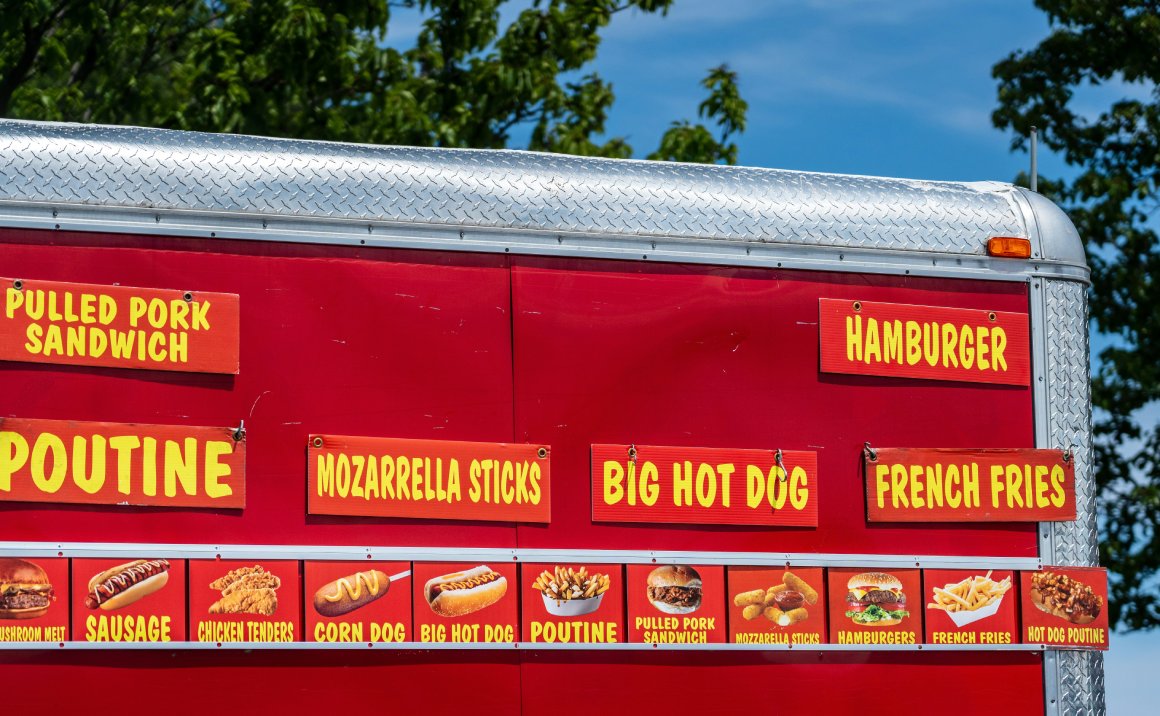
Crafting the Perfect Food Truck Menu: Efficiency, Speed, and Versatility
This post is part of a regular series. Click here to start at the beginning.
Building a food truck menu is about more than just offering delicious food—it’s about creating dishes that are easy to prepare, quick to serve, and cost-effective to produce. The success of your food truck often hinges on how well you balance flavor with practicality, especially when you’re dealing with the limitations of a small kitchen and high customer demand. An efficient menu helps reduce prep time, minimize food waste, and keep your operations running smoothly during busy periods.
In this post, we’ll break down the key considerations for building an optimized food truck menu. We’ll cover how to choose quick-to-make dishes, reuse ingredients across multiple menu items, and keep your offerings versatile without overwhelming your kitchen. To help you get started, we’ll also provide sample menus for popular food truck concepts, including taco trucks, BBQ trucks, burger trucks, and Asian fusion trucks.
1. Focus on Easy-to-Make, Quick Foods
When building a food truck menu, it’s essential to prioritize dishes that are easy to prepare and can be served quickly. Since food trucks operate in a fast-paced environment, your customers will expect to receive their orders promptly—especially if they’re grabbing food on the go during lunch breaks or events.
How to Implement This Tip:
- Select Simple, Flavorful Dishes: Choose menu items that don’t require complex cooking techniques or long prep times. Focus on dishes that pack a punch in flavor but can be executed with minimal ingredients and equipment.
Example: A taco truck might offer simple options like grilled chicken, beef, or vegetarian tacos with minimal toppings. Each protein can be grilled or pre-cooked and quickly assembled with fresh salsa, guacamole, and lime. - Limit Items That Require Long Cooking Times: While slow-cooked or braised dishes are delicious, they may not be practical for a busy food truck. If you want to offer such items, consider preparing them in advance or using specialized equipment that speeds up the cooking process.
Example: A BBQ truck might prepare pulled pork or brisket in advance, allowing it to be reheated and served quickly during service hours. This ensures that customers can still enjoy the smoky, slow-cooked flavors without waiting long. - Use Equipment That Speeds Up Cooking: Invest in high-efficiency kitchen equipment, such as griddles, fryers, or panini presses, that allow you to cook items quickly. Avoid menu items that require specialized or slow-cooking equipment unless you can prep them in advance.
Example: A burger truck might use a flat-top grill to cook patties quickly, ensuring that burgers can be made to order and served within minutes.
Expected Results:
- Faster Service Times: Prioritizing easy-to-make foods allows your team to prepare orders quickly, reducing wait times for customers.
- Reduced Complexity in the Kitchen: Keeping the menu simple helps your team stay organized and focused, even during busy periods.
- Measurable Impact: Track how long it takes to complete orders and monitor customer satisfaction to ensure that your menu choices align with your operational capacity.
2. Reuse Ingredients Across Multiple Dishes
One of the most effective ways to streamline your menu and reduce costs is by reusing ingredients across multiple menu items. This not only helps you keep inventory simple but also reduces food waste by ensuring that each ingredient has multiple uses.
How to Implement This Tip:
- Choose Versatile Ingredients: Focus on ingredients that can be used in a variety of dishes. Proteins like chicken, beef, or tofu, and base ingredients like rice, tortillas, or bread, can be featured in multiple menu items, allowing you to create variety without complicating your kitchen.
Example: A taco truck might use the same grilled chicken for tacos, burritos, and quesadillas. By preparing a large batch of chicken at the start of the day, the team can quickly assemble different menu items using the same protein. - Create Menu Items With Similar Components: Design your menu so that different dishes share similar components, such as sauces, toppings, or sides. This minimizes the number of unique ingredients you need to keep in stock and ensures that your kitchen runs efficiently.
Example: A burger truck might offer a range of burgers, but each one is topped with similar ingredients—lettuce, tomatoes, onions, and cheese. This way, the team only needs to prep a handful of toppings that can be used on multiple burger varieties. - Rotate Specials Using Existing Ingredients: If you want to offer seasonal or limited-time specials, try to incorporate ingredients you already use. This allows you to introduce variety without complicating your supply chain or adding new items to your inventory.
Example: A BBQ truck might use leftover pulled pork to create a “Pulled Pork Nachos” special, incorporating ingredients like cheese, jalapeños, and salsa, which are already used for other dishes.
Expected Results:
- Lower Food Costs: Reusing ingredients across multiple dishes allows you to buy in bulk and minimize waste, reducing your overall food costs.
- Simplified Inventory Management: Keeping your ingredient list short and versatile makes it easier to manage inventory and avoid over-ordering or spoilage.
- Measurable Impact: Track inventory usage and food waste to assess the efficiency of your menu and identify opportunities to further optimize ingredient usage.
3. Keep Your Menu Flexible but Focused
While it’s important to offer variety, your food truck menu should be focused enough to ensure consistency and efficiency. Having too many options can slow down your kitchen and overwhelm customers, so aim for a balance that allows for flexibility without overcomplicating things.
How to Implement This Tip:
- Limit the Number of Core Menu Items: Aim to offer a handful of core menu items (5-10) that are easy to execute and can be customized with different toppings or sides. This gives customers options while keeping your kitchen focused on a manageable number of dishes.
Example: A taco truck might offer five core taco options: chicken, beef, pork, vegetarian, and fish. Each taco can be customized with different toppings, but the core ingredients remain the same, allowing the kitchen to operate efficiently. - Offer Customizable Options: Let customers personalize their meals by offering a few customizable elements, such as toppings, sauces, or sides. This provides variety without requiring you to prepare entirely different dishes.
Example: A burger truck allows customers to choose from a variety of toppings and sauces, such as avocado, jalapeños, and BBQ sauce. This customization adds variety to the menu without adding complexity to the kitchen. - Introduce Limited-Time Specials: Specials are a great way to keep your menu exciting without making permanent changes. You can rotate limited-time items based on seasonal ingredients, customer demand, or new recipes you want to test.
Example: A smoothie truck introduces a “Seasonal Fruit Smoothie” that changes based on what’s available locally. This keeps the menu fresh while using ingredients that are already in stock for other smoothies.
Expected Results:
- Streamlined Operations: A focused menu reduces the risk of confusion or delays in the kitchen, helping your team work more efficiently during busy periods.
- Increased Customer Satisfaction: Offering customizable options allows customers to tailor their meals to their preferences, creating a more personalized dining experience.
- Measurable Impact: Track sales data to see which core menu items and customizable options are most popular, and adjust your menu based on customer preferences.
4. Sample Menus for Popular Food Truck Concepts
To help you get started, here are sample menus for four popular food truck concepts: taco trucks, BBQ trucks, burger trucks, and Asian fusion trucks. Each menu is designed with versatility, simplicity, and efficiency in mind, demonstrating how you can reuse ingredients and create quick-to-make dishes.
Sample Taco Truck Menu:
- Grilled Chicken Taco – Chicken, salsa, guacamole, lettuce, and lime
- Beef Carne Asada Taco – Marinated beef, onions, cilantro, and salsa verde
- Vegetarian Taco – Grilled vegetables, black beans, avocado, and queso fresco
- Fish Taco – Fried or grilled fish, cabbage slaw, pico de gallo, and chipotle mayo
- Pork Carnitas Taco – Slow-cooked pork, onions, cilantro, and salsa roja
Common Ingredients: Tortillas, salsa, lettuce, onions, cilantro, guacamole, limes
Sample BBQ Truck Menu:
- Pulled Pork Sandwich – Pulled pork, BBQ sauce, coleslaw, and pickles
- Brisket Plate – Sliced brisket, potato salad, baked beans, and bread
- BBQ Chicken Plate – Grilled chicken, cornbread, coleslaw, and green beans
- Rib Plate – Smoked ribs, BBQ sauce, mac & cheese, and baked beans
- BBQ Nachos – Pulled pork, cheese sauce, jalapeños, BBQ sauce, and sour cream
Common Ingredients: BBQ sauce, coleslaw, baked beans, cornbread, cheese
Sample Burger Truck Menu:
- Classic Cheeseburger – Beef patty, cheddar, lettuce, tomato, onions, and ketchup
- Bacon Burger – Beef patty, bacon, cheddar, BBQ sauce, and grilled onions
- Veggie Burger – Black bean patty, avocado, lettuce, tomato, and chipotle mayo
- Mushroom Swiss Burger – Beef patty, sautéed mushrooms, Swiss cheese, and garlic aioli
- BBQ Chicken Sandwich – Grilled chicken, BBQ sauce, coleslaw, and pickles
Common Ingredients: Burger buns, lettuce, tomato, onions, BBQ sauce, cheese, pickles, and condiments
Sample Asian Fusion Truck Menu:
- Korean BBQ Beef Tacos – Marinated beef, kimchi slaw, green onions, and sesame seeds
- Teriyaki Chicken Rice Bowl – Grilled teriyaki chicken, steamed rice, broccoli, and carrots
- Spicy Tofu Bao Buns – Fried tofu, pickled vegetables, hoisin sauce, and cilantro
- Shrimp Spring Rolls – Shrimp, rice noodles, mint, lettuce, and peanut sauce
- Pork Belly Banh Mi – Crispy pork belly, pickled vegetables, cucumber, and sriracha mayo on a baguette
Common Ingredients: Rice, pickled vegetables, cilantro, sesame seeds, sauces (hoisin, sriracha, teriyaki)
Conclusion: Crafting a Smart, Efficient Food Truck Menu
Building a successful food truck menu is about striking the right balance between variety and simplicity. By focusing on easy-to-make dishes, reusing ingredients across multiple menu items, and offering customizable options, you can create a menu that’s not only appealing to customers but also efficient to execute. Whether you’re running a taco truck, BBQ truck, burger truck, or Asian fusion truck, the principles of versatility, speed, and consistency will help you streamline your operations and keep your customers coming back for more.
Your menu is a reflection of your food truck’s identity, so take the time to design it with both flavor and practicality in mind. By optimizing your menu for efficiency, you’ll be better equipped to handle high demand, reduce food waste, and keep your operations running smoothly even during peak times.
Stay tuned for more posts on running a successful food truck business, from marketing strategies to operational tips, to help you grow and thrive in the competitive world of mobile food service!
This post is part of a regular series. Please use these links to view the rest of the series in order.
Summary of Customer Engagement and Retention Strategies for Your Food Truck
The Complete Guide to Customer Engagement and Retention for Food Truck Owners ustomer engagement and…
Creating a Loyalty Program for Your Food Truck
How to Build a Loyalty Program that Drives Repeat Business for Your Food Truck Loyalty…
How to Build Social Media Engagement for Your Food Truck
Boosting Social Media Engagement: A Guide for Food Truck Owners In today’s digital world, social…




